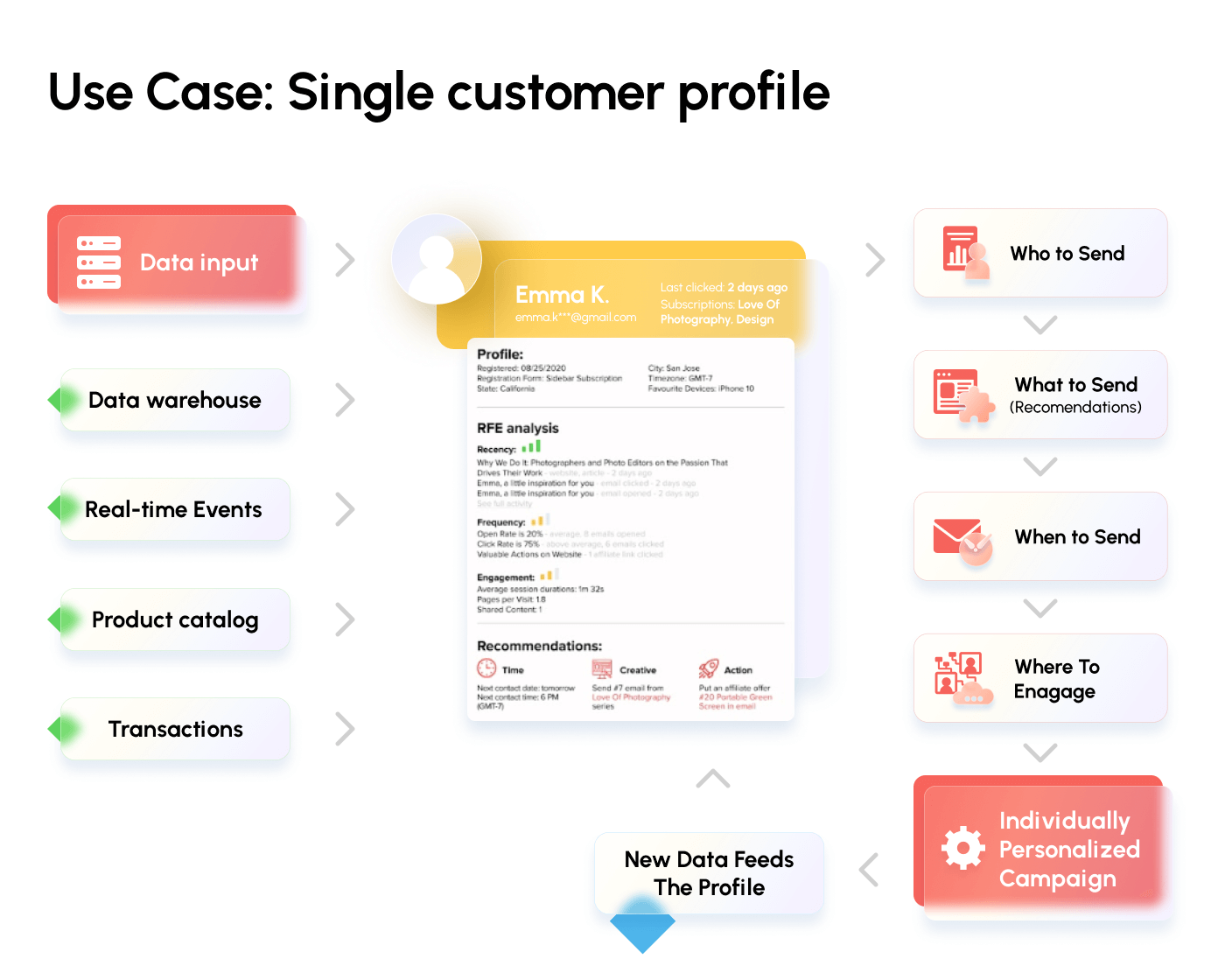7 Ways to Increase Results Using Artificial Intelligence
Artificial intelligence’s rapid development made this technology accessible to many industries and professionals, including marketers. Introducing AI to your email marketing activities is now easier than you think. Let’s dive in and learn more about how you can improve your email marketing results with the help of AI.

Artificial intelligence’s rapid development made this technology accessible to many industries and professionals, including marketers. Introducing AI to your email marketing activities is now easier than you think. Let’s dive in and learn more about how you can improve your email marketing results with the help of AI.
New approach towards marketing
We’re living in the times of constant changes for entrepreneurs. The way marketing was done 20 years ago can no longer be introduced in modern companies and business strategies need to be revised every year.
It encouraged many entrepreneurs and business professionals to reevaluate their tactics. From a product-centered perspective to a very client-centric approach. Customers are well aware of marketing tactics and it’s even more challenging to attract their attention.
When it comes to email marketing, this challenge is even harder. Back in the 1990s, when the internet was still a novelty, emails were booming. Marketers saw a great opportunity and used this channel often. Since the introduction of anti-spam regulations, email professionals needed to adjust their efforts to reach desired results.
It is the right moment for companies to introduce AI into their business.
Even though it might seem like a distant future, pictured by machines taking over people’s everyday lives, it’s not as dark or complicated. Largest players and pioneers in their fields, such as Google, Amazon, or Facebook, have successfully incorporated AI elements into their products.
Think about Amazon’s recommendations for similar items, YouTube’s suggested videos, or Google’s speech recognition. The list goes on and only confirms the wide use of artificial intelligence, machine learning, and natural language processing to improve both users’ experience and companies’ competitive advantage.
Artificial Intelligence is here to stay
The main focus of today’s email marketers is providing value to their customers and convincing them to perform a certain action. This comes to creating the right subject line, content, CTA, and design. However, to make it right, it needs time and proper brainstorming, testing new ideas, segmenting the audience, tailoring the content, and so on.
Luckily, we have a variety of resources at our fingertips and they are easier to implement than we think. At InboxSuite we advocate artificial intelligence. Our innovative solution for dynamic marketing teams helps them increase revenues from the email channel.
According to research held by OneSpot and The Relevancy Group, 96% of surveyed marketers are confident that machine learning can personalize email content to match individual interests while improving customer experience.
In this article you’ll find out what you as an email marketer can do to improve your work and let AI tackle the most time-consuming processes.
Let’s walk through 7 most significant ways to use AI in email marketing to boost revenues and reduce churn.
1. Managing and organizing your data
When we look at successful implementations of AI in email marketing, we notice that companies have their customer data from all different sources integrated and available for the AI system to learn from.
Here’s what a typical AI workflow would look like:

First, you need to identify the business problem you’d like to solve and put all the data into the system. From here AI can provide predictions. These are useful in the decision-making process that leads to experimenting and drawing conclusions that can improve your email marketing efforts.
Managing and organizing data is a starting point to perform any kinds of tasks or activities further on.
There are over 306 billion emails being sent daily all around the world. This number is only expected to increase in the following years and it will bring more challenges. It also means billions of emails being received each day. With all the inbox noise it’s extremely important to understand what subscribers look for and what they instantly get rid of.
Managing and organizing such amounts of data is a task for a whole team. It’s not only taking plenty of time for marketers and analysts, it also creates a threat of making costly mistakes along the way.
Subscribers have multiple data points and to get a full picture, they require proper management. Traditional organization methods are not capable of managing very high numbers of information, so a new approach had to be introduced.
AI can easily take over this task, analyze large amounts of data and organize them into a more tangible form. From here, email marketers can discover and group similar customers using demographic, behavioral and transactional data, which later on is helpful in planning content or tailoring it to subscribers’ interest.
What artificial intelligence does here is allow marketers to focus their efforts on planning and strategizing next steps, while machines take care of big data creating lookalike audiences.
Let’s take a look at an example:

In this case, custom CRM records are taken into consideration along with the attributes for each customer, and as a result, the AI system brings similar customer groups together.
Once we applied AI-based clustering to one of our own web properties, we noticed a significant increase in our email marketing ROI from 70% to 110% compared to a standard approach.
2. Segment of one
Clustering similar data brings us to the next point, which is a Segment of One strategy.
Put simply, it’s the most sophisticated way to communicate with a customer. As it was mentioned before, your subscribers are much more aware of the messages they receive and they require a more personal approach.
Using computational algorithms allows you to create a Segment of One. As you develop a single customer profile, each of them becomes a new segment. It’s based on data points such as demographics, lifetime attributes, interests, engagement patterns, past interactions, and so on.
Thanks to this, it’s possible to run an individual communication sequence with personalized content and a schedule tailored to single customer’s preferences.

3. Customer Lifetime Value prediction
A well-designed Segment of One model can lead to higher Customer Lifetime Value. This metric tells the total revenue you can expect from a single customer. And it can be predicted by Artificial Intelligence.
Why do we need a prediction in the first place? It allows you to prioritize profitable acquisition channels. If you’re getting the most revenue from emails, it’s only natural to invest more in them and develop the channel further – this way you’re spending your marketing budget wisely, without any blind guesses. Consequently, you're able to revise your strategies, apply those that work best, and optimize the customer journey.
Once you know the CLV, you can improve it and work on retaining your existing customers through email marketing. It’s a key metric for long-term business growth that allows you to understand if you are on the right track, or maybe if there are things to change.
Here’s an example to give you a better view on CLV prediction.
One of our clients wanted to calculate their future revenue and decided to use our AI solution to reduce discrepancy between the actual calculations and the predicted ones.

As you can see in the chart above, discrepancy between predicted clicks and actual ones is extremely low – a total of 0.71%. With AI it was possible to predict results with great accuracy. This is something extremely difficult to achieve using traditional calculating methods, plus they would take plenty of time. CLV prediction can be an excellent tool in the arsenal of today’s modern email marketers, who want to create tangible plans for future development.
4. Email content personalization
With the high number of emails being delivered to inboxes daily, it’s crucial to develop a personalized approach towards your customers and encourage them to open your message. Individual segmentation allows you to achieve just that.
It’s common practice to test different subject lines, CTAs, copy, images, etc. But again, these actions are extremely time-consuming, both working on them and analyzing the results afterwards.
Artificial intelligence, on the other hand, can quickly predict which combinations will bring more conversions, and apply these elements in the email content.
How does it do that?
NLP (Natural Language Processing) makes it possible to generate engaging content that can resonate with your subscribers. Machines can already write content based on preset formats and rules; they do, however, require a human eye to examine whether texts look as if they were made by a person. Back in 2015 Gartner was predicting that by 2018 20% of all online content would be generated by machines. There’s no updated research yet, however many companies have since invested in developing and implementing AI in their marketing structures.
Apart from content, there’s another important thing subscribers look at, and it’s the email design. There are people who prefer simple text messages and others who enjoy a neat design with a header and clean copy. Machine learning algorithms analyze these personal preferences and adjust the image to text ratio with other design elements. Given the Segment of One approach and personalized content, your subscribers can receive exactly what they want – engaging content that will build better relationships with your company.
One of the examples worth sharing is Domino’s Pizza. The company was facing a couple of challenges:
- Keeping the brand voice,
- Becoming more competitive,
- Engaging customers in the CRM database.
They decided to use AI to optimize their email subject lines. Instead of sending out messages with a general subject, they were referring to subscribers’ most common interaction patterns. As a result, in just 2 months Domino’s increased their open rates by 26% and clicks by 57%. In total making 753% ROI.
5. Send time and frequency optimization
Grabbing your customers’ attention is one thing, but getting to them at the right time, so that your email doesn’t get flooded in the inbox, is a whole other story. You need to consider the time of delivering the email and the frequency of sending. If you don’t send often enough, your subscribers might forget about you. On the other hand, too many emails may cause an increased unsubscribe rate.
People often argue which time is the best to send email campaigns and how often it should be done. This debate is similar to posting on social media channels – marketers need to know exactly when the audience is the most active, so that they can see their content. It’s even more challenging when customers are active during different hours and tailoring the send time may negatively affect some part of the audience. It’s impossible to estimate the right sending time for each subscriber, but AI can do it for you.
Based on past activity, time zones, and habits, machine learning algorithms can define when to send an email with the highest likelihood to get opened.

Our case study shows how traditional and AI-based methods can bring completely different results. With the standard method, it was more difficult to predict which frequency would lead to the highest number of actions. In the AI case the results were better thanks to optimized send time and frequency.
AI can increase engagement, lower the churn rate, and more, if you apply it to your message timing.
6. High and stable deliverability
Even if you take into account all the previous steps – polish your content, design, optimize sending time, and create individual segments – it can all go to waste if you don’t pay enough attention to deliverability. Maintaining good email deliverability requires list hygiene, sending domain and IP reputation, subscriber engagement, and so on.
You can do all those things by yourself or give it to machines. Here’s how AI can help.
Email verification at import: The moment you import subscribers to the system, all email addresses are verified by a 3rd party partner. At this stage all bad addresses (spam, blacklisted emails) are removed. This gives you a cleaner list to start with and a lower risk of decreasing your deliverability.
Preliminary testing: The AI system runs preliminary tests and identifies, if there are any issues such as spammy words, blacklisted domains, or broken links.
AI-driven automated warm-up: The AI solution also helps with a fully automated warm-up phase. It decides how many messages should be sent to which domain family and at what pace. If done manually, it would be a lengthy stage. But with the right segmentation and personalized content, AI can significantly speed up the process.
Optimizing resend rules: AI-based systems can recognize ISP minute signals and optimize the resend rules.
7. Customer journey optimization
We interact with each customer at a different stage of their journey with our brand. It is important to understand what each customer wants. Our job is to provide them with the right experience.
It’s not possible to do it all manually, especially as we have more channels and devices for customer-company interaction.
Acquiring new subscribers and customers is the most important stage. You should always send a series of welcome messages for stronger engagement. AI can help you stimulate subscribers’ interest through optimized content and personalized offers.
As subscribers are more active, algorithms can predict their behavior and provide relevant products and promotions.
Engaged customers have different motivation levels so brands should provide unique experiences. AI reads the digital body language of customers and puts the predictions at work. Based on the interactions, AI sends the right message at the right time.
When it comes to inactive subscribers, there should be even more focus put by the brands. AI can keep those subscribers interested by sending new and engaging content along with exclusive promotions and benefits.
And finally, AI can predict churn, so that companies can send win-back campaigns and bring those subscribers back to the customer cycle.
What comes next
AI carefully analyzes how subscribers behave and react to email messages. It measures the engagement, number of clicks, and open rates. Based on those it can create even more personalized content that will further develop segments. This aggregated information helps email marketers plan their strategies.
After all, AI is here to help companies increase their customers’ engagement and build trust. The largest organizations have already incorporated artificial intelligence into their structures and others are ready to invest in it. It’s only a matter of time until machine-based marketing activities will become a standard in business.
For email marketers it’s an opportunity to create an incredibly personalized inbox experience for their subscribers and provide them with actual value.
With the help of AI email marketers can do more within the same amount of time and with better results. And thanks to human knowledge and expertise, artificial intelligence can follow paths that we create and set to work. The idea of smart solutions is to support us, not replace us. Without human’s work, AI becomes a series of pre-set carefully performed tasks. But it’s up to us, how we decide to use the provided data and results in our email marketing activities.
Curious how AI can help increase the results of your email campaigns? Schedule a demo with the InboxSuite team: https://inboxsuite.com/demo.
Read also
Black Friday email strategies, tactics, and tips to try in 2022
There is one great certainty in life: Black Friday will come around every year, and it will be here faster than you imagine. As the largest sale event of the year, it is a huge opportunity for marketers - especially when it comes to the email strategy. How not to miss it and use it wisely? What results should I expect? What types of emails perform best? Should I use automation? Is there technology that can improve my Black Friday efforts? How should a perfect email be designed? How to write a good email subject line? On the Black Friday eve, you may ask yourself many questions. The InboxSuite team provides answers and presents best strategies, tactics, and tips for the best selling event of the year.
How Can Using AI in Email Marketing Help You Tackle Apple’s Privacy Changes with iOS 15?
For the last month, the most popular discussion topic in the email marketing community are Apple’s latest privacy updates. How will this change affect email marketing programs? Is it another apocalypse time for email? What can email marketers do to prepare and how can AI help us evolve our email marketing program? We’ll have a deep dive into the topic, bring you suggestions from experts, and help you become bulletproof for any regulation updates. Buckle up!
Top challenges for email marketers in 2022 and how to tackle them
2021 was a very successful year for email marketers. According to Litmus, More than 40% of brands defined email marketing as “very critical” for overall success. Email has once again proved that it’s not dead. At InboxSuite, we are very positive about 2022; as more budgets are allocated for this year, more email marketers will be hired, and more money will flow into agencies and freelancers.
 Resources
Resources


